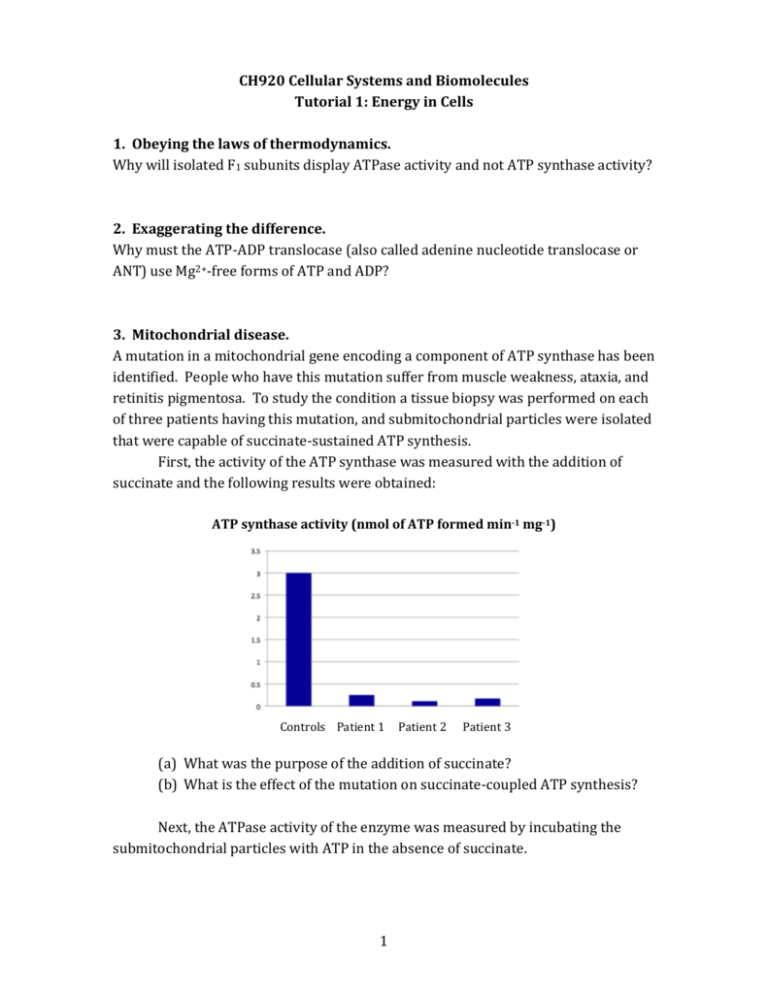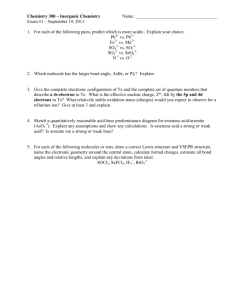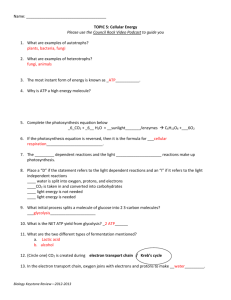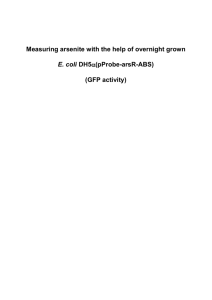CH920 Cellular Systems and Biomolecules Tutorial 1: Energy in
advertisement

CH920 Cellular Systems and Biomolecules Tutorial 1: Energy in Cells 1. Obeying the laws of thermodynamics. Why will isolated F1 subunits display ATPase activity and not ATP synthase activity? 2. Exaggerating the difference. Why must the ATP-ADP translocase (also called adenine nucleotide translocase or ANT) use Mg2+-free forms of ATP and ADP? 3. Mitochondrial disease. A mutation in a mitochondrial gene encoding a component of ATP synthase has been identified. People who have this mutation suffer from muscle weakness, ataxia, and retinitis pigmentosa. To study the condition a tissue biopsy was performed on each of three patients having this mutation, and submitochondrial particles were isolated that were capable of succinate-sustained ATP synthesis. First, the activity of the ATP synthase was measured with the addition of succinate and the following results were obtained: ATP synthase activity (nmol of ATP formed min-1 mg-1) Controls Patient 1 Patient 2 Patient 3 (a) What was the purpose of the addition of succinate? (b) What is the effect of the mutation on succinate-coupled ATP synthesis? Next, the ATPase activity of the enzyme was measured by incubating the submitochondrial particles with ATP in the absence of succinate. 1 ATP hydrolysis (nmol of ATP hydrolyzed min-1 mg-1) Controls Patient 1 Patient 2 Patient 3 (c) Why was succinate omitted from the reaction? (d) What is the effect of the mutation on ATP hydrolysis? (e) What do these results, in conjunction with those obtained in the first experiment, tell you about the nature of the mutation? 4. Citric acid cycle. The activity of the citric acid cycle can be monitored by measuring the amount of O2 consumed. The greater the rate of O2 consumption, the faster the rate of the cycle. Hans Krebs used this assay to investigate the cycle in 1937. He used as his experimental system minced pigeon-breast muscle, which is rich in mitochondria. In one set of experiments, Krebs measured the O2 consumption in the presence of carbohydrate only and in the presence of carbohydrate and citrate. The results are shown in the table below: Effect of citrate on oxygen consumption by minced pigeon-breast muscle (a) How much O2 would be absorbed if the added citrate (3m) went completely oxidized to H2O and CO2? (b) On the basis of your answer to part a, what do the results given in the table suggest? 2 5. Arsenite poisoning. The effect of arsenite on the experimental system of problem 5 was then examined. Experimental data (not presented here) showed that the amount of citrate present did not change during the course of the experiment in the absence of arsenite. However, if arsenite was added to the system, different results were obtained, as shown in the table below: Disappearance of citric acid in pigeon-breast muscle in the presence of arsenite (a) What is the effect of arsenite on the disappearance of citrate? (b) How is the arsenite’s action altered by the addition of more citrate? (c) What do these data suggest about the site of action of arsenite? 6. Fats into glucose? Fats are usually metabolized into acetyl CoA and then further processed through the citric acid cycle. Glucose can be synthesized from oxaloacetate, a citric acid cycle intermediate. Why, then, after a long bout of exercise depletes our carbohydrate stores, do we need to replenish those stores by eating carbohydrates? Why do we not simply replace them by converting fats into carbohydrates? 3











